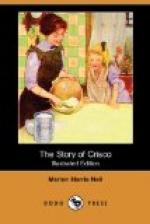[Illustration]
Six Hundred and Fifteen Tested Recipes
“Calendar of Dinners”
[Illustration: Crisco]
by Marion Harris Neil
SOUPS
An economical housewife may supply good gravy and thick soups at very little, if any, addition to the weekly expenses, as soups are an excellent method of using up scraps and bones from joints and vegetables that otherwise are wasted. Soup, if taken as the primary course of a substantial dinner, if well flavored and warm, acts as a stimulant in the stomach, exciting the gastric glands, and generally enabling that organ to perform its functions more easily. For this object the soup should be thin and not too much of it partaken, otherwise it dilutes the digestive juices too much. If it is to form the chief part of the meal, the soup will be more nutritious if thickened, especially so, if pulse—i.e. peas, beans, and lentils—is used as the thickening medium.
Stock is the liquid in which meat, bones, or vegetables have been cooked, and which contains an extract from these substances. It is used for soups, sauces, and gravies. Fresh or cooked bones or meat may be used. A stock pot may be kept on the stove, into which are put any scraps of meat, bones, gristle, or vegetable; at the end of the day it is strained, and all fat taken off. Bones and meat for stock must be broken into small pieces. Cold water should be used, and a little salt to extract the nutriment. The whole must be brought slowly to the boiling point; then, the temperature lowered, the fat and scum taken off. When wanted for clear soups the vegetables should be cleaned, but not cut up, or with the long cooking they may mash and thicken the soup. In hot weather it is better to leave out the vegetables, as the stock turns sour more quickly if vegetables have been used in its preparation. They can be cooked separately and added when using the stock.
[Illustration]
The soup should simmer for five or six hours to extract the gelatinous matters. If the stock is skimmed occasionally it will be much clearer. Keep the lid on the stock pot to prevent loss by evaporation. The bones can be cooked again next day for a second stock, but the vegetables must be taken out. Care must be taken that nothing doubtful in freshness be put into the stock pot. Meat and bones should be well wiped with a damp cloth before using them. If onions be put in the soup unpeeled, simply washed and the root end cut off, they will help to color the soup. When using eggs for other dishes, if the shells be washed before breaking them and added to the stock pot they will help to clear the soup. For clear soups care must be taken that nothing of a floury nature be added to the stock pot. Stock always should be strained before cooling. Never allow it to stand in stock pot all night. Clear gravy soup consists of the extractives, flavoring matters, and gelatine of meat and bones.




